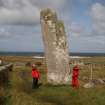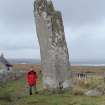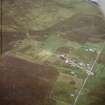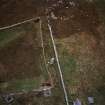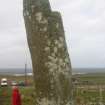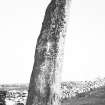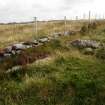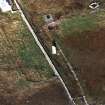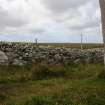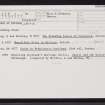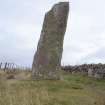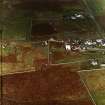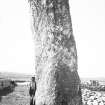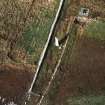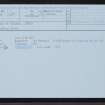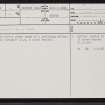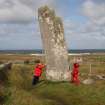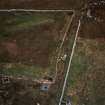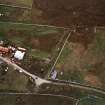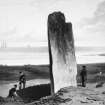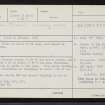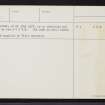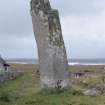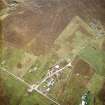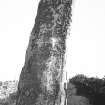Pricing Change
New pricing for orders of material from this site will come into place shortly. Charges for supply of digital images, digitisation on demand, prints and licensing will be altered.
Lewis, Clach An Trushal
Standing Stone (Prehistoric)
Site Name Lewis, Clach An Trushal
Classification Standing Stone (Prehistoric)
Alternative Name(s) The Thrushel Stone; Truiseil
Canmore ID 4264
Site Number NB35SE 1
NGR NB 37560 53779
Datum OSGB36 - NGR
Permalink http://canmore.org.uk/site/4264
- Council Western Isles
- Parish Barvas
- Former Region Western Isles Islands Area
- Former District Western Isles
- Former County Ross And Cromarty
NB35SE 1 37560 53779
(NB 375 537) Clach an Trushal (NR)
OS 6" map, Ross-shire, 2nd ed., (1898)
The Thrushel Stone is about 20ft high, and almost as much in breadth.
M Martin 1934.
The Clach an Trushal stands 18ft 10 ins above ground, and measures about 6ft in width, 3ft 9 ins max. thickness, and 15ft 7 ins in girth at the base. From about halfway up the stone diminishes in thickness to about 1ft at the top. It faces nearly ESE and slants slightly to the S and W.
RCAHMS 1928, visited July 1914.
Clach an Trushal, at NB 3755 5377, is as described and illustrated by the RCAHMS. The name is still known locally.
Visited by OS (N K B) 18 June 1969.
NB 3755 5377 The Trushal Stone is a standing stone famous for its size - 5.8m tall - reputed to be the tallest in Scotland.
There is no reference to any other standing stones in the immediate vicinity, either on the OS maps or in the literature, but local knowledge states that it once had a stone circle around it "like at Callanish", and that the stones were broken up and incorporated in nearby field walls and used as lintels in houses. They are known as 'blue stones'. The last erect standing stone "was cylindrical and was dug up" and used as a lintel in a local house shortly before the RCAHMS visit in July 1914.
The Trushal Stone stands between two parallel field walls 8m apart, the wall on the SW side having been built sometime between 1898-1914, and the other a few years later.
Survey confirms that in these field walls there are many stones which have originated from the standing stones of the circle. These field walls come to within 3m of the Trushal Stone and extend to about 60m and 20m NW and 30m SE. Some stones are unbroken sausage shapes, about 0.4 x 0.4 x 1.5m long, and others are truncated cylinders of stone with sharp-edged breaks, and with a cross-section of about 0.4 x 0.4m. It is possible to differentiate these stones from the larger till stones generally used for the lowest course in the field walls hereabouts.
Based on the locations of the concentrations of these stones, and assuming that the builders of the walls would move the stones the minimum distance, it is possible to estimate where the stones of the reputed circle would have stood. Due to thorough field clearance and present soil cover, we found no visible evidence of stone holes or packing stones in situ.
For a distance of 17m NW of the Trushal Stone, the ground is relatively level, after which it slopes down. For 13m to the SE it is again relatively level, after which it slopes up. This suggests a cut-and-fill modification to the natural ground surface to make a near-horizontal platform to accommodate a standing stone circle. Such platforms exist at other stone circles in the Outer Hebrides.
There is evidence, both physical and oral, for the former existence of a ring of stones around the Trushal Stone, which may not have stood centrally. The stones are likely to have been about 1.5m tall, and the ring is likely to have been about 28-30m in diameter. It may have been circular, oval or flattened. Its centre would have been about 6m N of the Trushal Stone.
A slab, 0.75 x 1.50 x 0.20m thick, lying at an angle of 30º and with a void under it, may be an outlier. It is 35m NE of the Trushal Stone, and about 12m outside the ring.
Lying near the base of the Trushal Stone are two large stones: a block, 0.55 x 0.65 x 1.30m, which may have broken away from the top; and a slab, >0.18 x 0.90 x 1.15m, which may have broken away from the N edge.
M R Curtis and G R Curtis 2002
This impressive stone stands between two walls with the ground rising to the SE onto the moor above. There are two large blocks lying at its base immediately to the NE and many more are incorporated in the foundation course of the adjacent walls. Traditionally it is thought to have stood adjacent to, or formed part of, a stone circle, and in 2006 the sockets of three stones, one of which was preceded by a timber post, were revealed by excavation in the area immediately to the NE (see NB35SE 67).
Visited by RCAHMS (ARG, SPH) 29 August 2009
Field Visit (10 July 1914)
Standing Stone, Clach an Trushal, Ballantrushal.
On the gentle slope of a hillside, falling towards the north about ¼ mile northwest of the fifteenth milestone on the Stornoway and Ness road, in the township of Ballantrushal, at an elevation of about 100 feet above sea-level, is the magnificent monolith, Clach an Trushal, standing 18 feet 10 inches above ground, and measuring about 6 feet in width, 3 feet 9 inches at its greatest thickness, and 15 feet 7 inches in girth at the base, which is somewhat lenticular on plan. The stone diminishes very slightly in width for the greater part of its height, but from about half-way up it tapers to a thickness of about 1 foot at the blunt top. It faces nearly east-south-east and slants slightly to the south and west. (Fig. 269.)
RCAHMS 1928, visited 10 July 1914.
Publication Account (1985)
Reputed to mark the site of a battle, Clach an Trushal is an impressive standing stone, nearly 6m high, leaning slightly to the south. An early 19th century print shows several feet of peat being cut away from around the base, but no archaeological discoveries were reported at this time.
Information from ‘Exploring Scotland’s Heritage: Argyll and the Western Isles’, (1985).
Field Visit (29 August 2009)
This impressive stone stands between two walls with the ground rising to the SE onto the moor above. There are two large blocks lying at its base immediately to the NE and many more are incorporated in the foundation course of the adjacent walls. Traditionally it is thought to have stood adjacent to, or formed part of, a stone circle, and in 2006 the sockets of three stones, one of which was preceded by a timber post, were revealed by excavation in the area immediately to the NE (see NB35SE 67).
Visited by RCAHMS (ARG,SPH) 29 August 2009







































